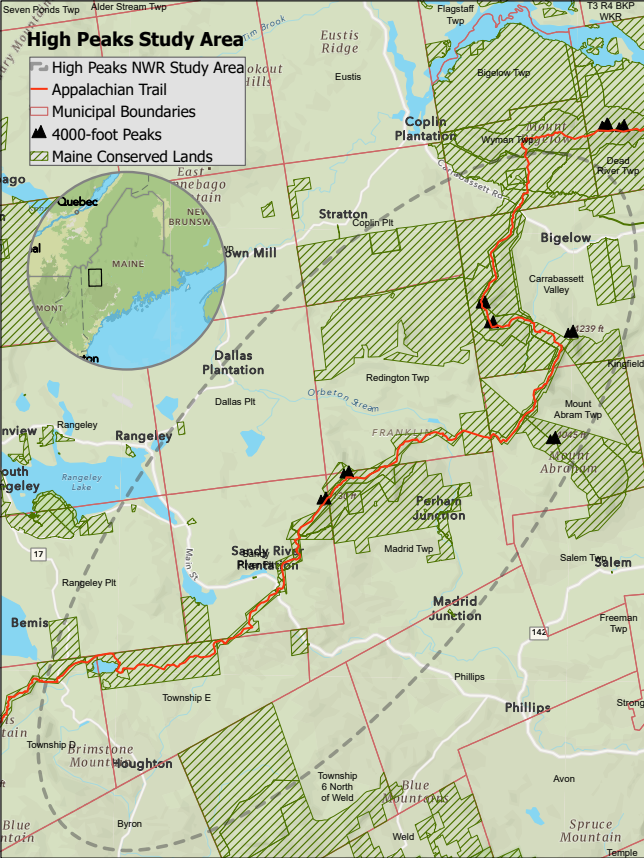FARMINGTON – The United States Fish and Wildlife Service hosted two scoping sessions in Franklin County last week to hear feedback from the community with regards to conservation in the High Peaks Region, particularly the potential for a National Wildlife Refuge.
One session was held in Rangeley on Tuesday, May 16, and the second was held in Farmington on Thursday, May 18.
The current study area is a wide swath of the High Peaks Region, including portions of Dallas Plantation, Rangeley Plantation, Sandy River Plantation, Phillips, Carrabassett Valley, Coplin Plantation, Byron, and the unorganized territories of Township E, Township D, Madrid Township, Salem Township, Redington Township, Mt. Abram Township, and Township 6.

This is a rough boundary and does not represent the entire proposed wildlife refuge, Paul Casey, a representative of USFWS and the lead on the project, explained. This study area provides a larger region within which the USFWS may consider creating a refuge.
During the scoping sessions, the USFWS sought feedback from the community on several topics related to land conservation in the High Peaks Region. This included the economic and recreation uses of the land, biological and ecological conservation needs, and the overall concept of a national wildlife refuge.
The scoping sessions are one of the first steps in a lengthy public process, Casey said. The process includes the scoping session to learn important parts of the region that may be benefited by a conservation agreement or a wildlife refuge. Once an area is identified within the study region, a draft land protection plan would be developed. The plan would then go out for public review and discussion with a 45-day comment period, and after revisions a final plan would be presented.
The plan may recommend no action, a preferred action, and secondary actions. These recommendations are based in part on the feedback gathered from the communities during the scoping sessions and public review.
Once a plan is established, it provides an ‘acquisition boundary’ where the USFWS can consider approaching landowners to see if they would consider selling property or entering into a conservation easement with USFWS to then create a wildlife refuge.
Casey reported that hunting, fishing, wildlife observation, photography, environmental interpretation and environmental education are key components in the USFWS operating principles for the wildlife refuge. He said that they would factor in local economics in the plan and that if an established use would interfere with wildlife, they would likely look to avoid that region in their planning process.
“We try to be a good neighbor,” Casey said.
At the Farmington session, several local leaders spoke with members of the USFWS, providing feedback. Franklin County Commissioner Bob Carlton expressed his concerns about adding another regulatory agency to the existing conservation land in the high peaks, stating that there’s approximately 80,000 acres already in conservation with local and state partners and private landowners, including 13,500 acres that were placed in conservation in the last two weeks. Carlton, a forester by trade, also shared concerns about the future of the economic base in the northern part of the county which relies heavily on outdoor recreation and activities such as hiking, skiing, snowmobiling, ATVing, hunting, and fishing.
In a meeting earlier in the week the county commissioners voted ‘not in favor’ of the proposed refuge, with Commissioners Carlton and Lance Harvell voting ‘not in favor’ and Commissioner Terry Brann abstaining from the vote.
State Senator Russell Black said he felt like the state agencies such as Inland Fisheries and Wildlife and the Bureau of Parks and Lands do a good job with land conservation, and asked what additional benefit the USFWS would provide in the area.
Tom Saviello, a forester and former State Representative, suggested that a national wildlife refuge would not be necessary in the area due to the preexisting conservation and land management plans.
Others spoke in favor of this proposal. Several residents of the community expressed interest in seeing more land in conservation, and exploring the possibility of a national refuge.
Nancy Perlson, a local conservation leader, supports the project. She said that the most important part of the process is hearing what people are interested in conserving. She also hoped to clearly communicate the goals and mission of the project, and to clarify that if the proposal moved forward, it would be in cooperation with the community and with the property owners. Perlson explained that the USFWS would likely seek unconserved property along the Appalachian Trail and near existing conservation land to fill in gaps and help expand the overall acreage of conserved land in the area.
Additional comments and feedback can be submitted via email to the USFWS at FW5mainehighpeaksplan@fws.gov




